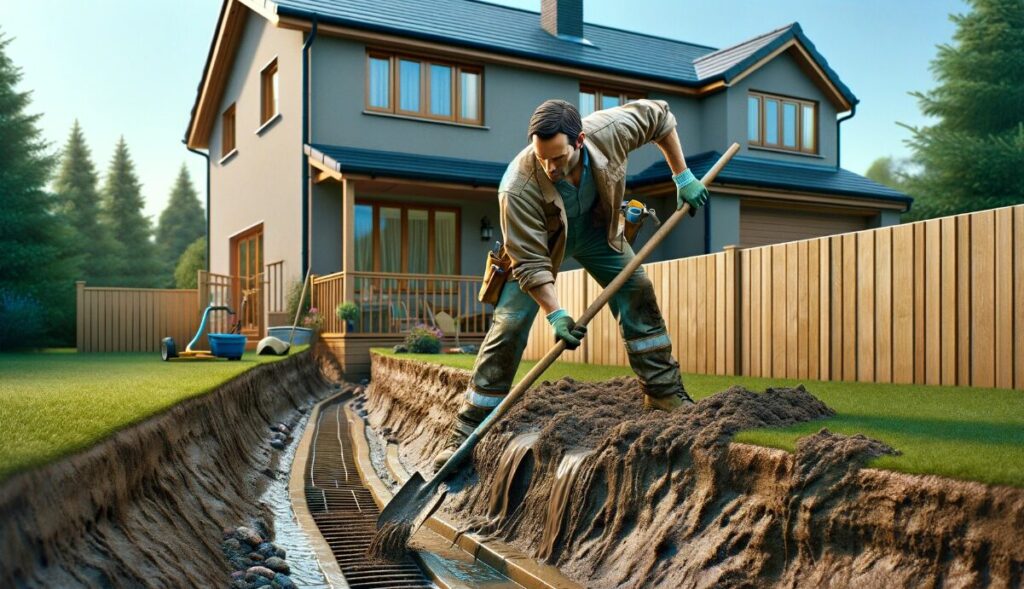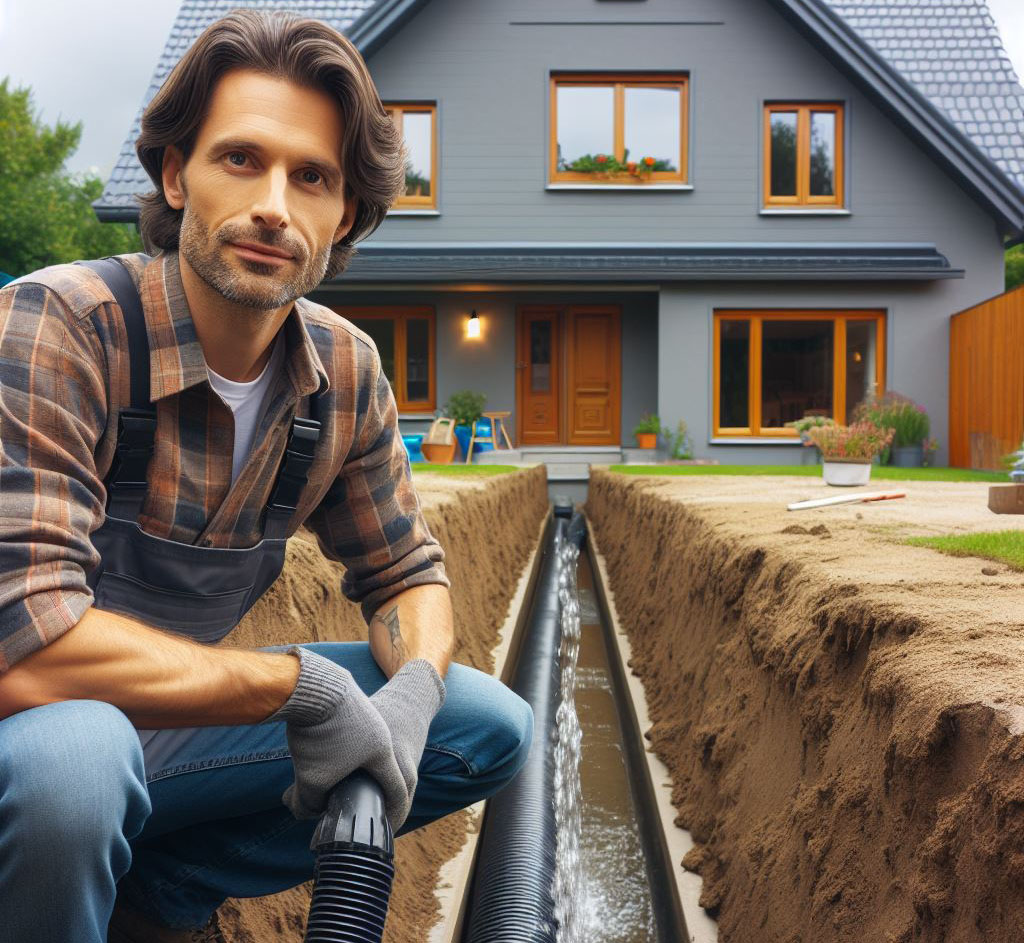In the nuanced world of home construction, understanding the subtleties of water management is paramount. A drainage swale stands as a testament to this, a seemingly modest yet profoundly impactful component of any well-planned landscape. This trench-like feature, when crafted with precision, not only safeguards your property against the perils of water damage but also enhances the overall health of your landscape.
Think of a drainage swale as an essential ally in your quest for a robust, water-resilient property. It’s not merely a ditch but a thoughtfully designed contour in your landscape, guiding excess water away from your structures and nurturing areas prone to saturation. Especially in regions where rainfall is more a deluge than a sprinkle, a well-executed swale drain is as vital as the foundation it protects.

Understanding Swale Drains
A drainage swale is a masterclass in simplicity and efficiency. Unlike its subterranean counterpart, the French drain, which hides away its water-wrangling prowess, a swale drain operates in plain sight. It harnesses the natural slope of your land, requiring nothing more than gravity to direct water away from your home and garden.
This unassuming hero serves multiple roles – from safeguarding your home’s foundation against the relentless pursuit of water to preventing the scourge of erosion in your garden. In times of sudden downpours, it stands as a bulwark, channeling potentially destructive torrents safely away from your cherished home.
Planning Your Drainage Swale
Embarking on the journey of creating a drainage swale involves more than just digging a trench, it’s a meticulous dance with the topography of your land.
- Spotting the Ideal Location: Begin by observing the natural behavior of water on your property. Identify areas where water gathers or races through during rainstorms. This insight is crucial in determining the path your swale will take, ensuring it works in harmony with the landscape rather than against it.
- Assessing the Landscape: Understanding the lay of the land, or the ‘grade’, is fundamental. A well-planned swale gently persuades water to flow along its course, careful not to hasten its journey and risk erosion or overwhelming downstream areas.
- Weather and Water Volume Considerations: Tailoring your swale to the whims of your local climate is a sage move. If you reside in an area prone to heavy rainfall, your swale should be robust enough to handle the deluge, channeling water efficiently without becoming overwhelmed.

Materials and Tools Needed
In the seasoned hands of a skilled builder, the right materials and tools aren’t just necessities, they’re the foundation of every successful project. When it comes to constructing a robust drainage swale, choosing top-notch materials and reliable tools is non-negotiable.
- Gravel: Opt for clean, coarse gravel. This isn’t just filler, it’s the bedrock of your drainage, ensuring a smooth, unobstructed water flow.
- Landscape Fabric: This unsung hero plays a crucial role. It separates your gravel from the soil, preventing sediment from clogging your swale and ensuring its efficiency and longevity.
- Pipes (Optional): For areas expecting heavy water flow, perforated pipes become essential. They’ll discreetly channel water away, preventing any possibility of waterlogging.
- Shovel: Choose a durable and comfortable shovel. Digging can be labor-intensive, and a quality shovel makes the difference between back-breaking work and a job well done.
- Rake: A robust rake is essential for evenly spreading gravel and soil, ensuring a level and functional swale.
- Level: Precision is key in water management. A reliable level ensures your swale has the correct gradient to efficiently guide water without causing erosion or overflow.
Pro Tip: Quality over quantity is the mantra here. Investing in high-grade materials and tools pays off in the long run, saving you time, money, and unnecessary headaches.
Step-by-Step Guide to Creating a Drainage Swale
- Marking the Area: Precision planning is essential. Use flags or landscape marking paint to outline your swale’s path, ensuring it complements your yard’s aesthetics and functionality. The goal is integration, not interruption.
- Excavating the Swale: With your path marked, it’s time to dig. Maintaining a gentle slope (a 1% incline is typically recommended) ensures your swale manages water flow without becoming a makeshift river. Aim for dimensions that suit your landscape’s unique requirements, though 18 inches wide and 8 to 12 inches deep is a good starting point.
- Layering and Support: First, lay the landscape fabric against the soil. This acts as a protective barrier, preventing the mixing of soil and gravel. Then, introduce a layer of gravel. This isn’t merely structural, it guides the water along the swale, ensuring efficient drainage.
- Enhancing Water Flow: For those expecting substantial water flow, incorporating a perforated pipe within the gravel layer offers an additional drainage avenue, discreetly funneling water away. After positioning the pipe, add another layer of gravel, followed by a top dressing of soil or mulch for a natural, inconspicuous appearance. To truly finesse your swale, consider planting native vegetation around it. Not only will this enhance the aesthetics, but it will also aid in water absorption and soil stabilization, preventing erosion and blending the swale seamlessly into your landscape.
Finishing Touches
After the foundational work of constructing your swale drain is complete, the focus shifts to seamlessly integrating this functional feature into the landscape and ensuring its longevity through attentive maintenance.
- Landscaping: Elevate the visual appeal of your swale by incorporating native, moisture-loving plants along its edges. This not only adds a layer of natural beauty to your landscape but also plays a functional role in water absorption and soil stabilization. These plantings, being native, require minimal care and contribute positively to the local ecology.
- Maintenance Tips: A swale drain, much like any integral part of your home’s exterior, requires regular maintenance to function optimally. Periodic checks to clear away natural debris such as fallen leaves or twigs are crucial to prevent blockages. Inspect the structure of the swale periodically, paying close attention to the integrity of its sides and the condition of the bottom, to ensure that it remains effective in managing water flow and preventing erosion.
FAQ Section
A swale drain is ingeniously simple: a shallow, landscaped channel that gracefully directs water away from areas where it’s unwelcome. It stands out from subterranean solutions like French drains by being an open, visible element of the landscape, marrying functionality with aesthetic appeal. Swale drains harness the natural topography of the land, relying on gravity and strategic landscaping to control water flow.
Identifying the optimal spot for a swale requires careful observation of your yard’s natural water flow and collection points. Pay attention to the land’s slope, as a swale needs a gentle gradient to function efficiently. Consider the destination of the diverted water as well—your aim is to reroute it away from structures, not towards neighboring properties.
To ensure the longevity and functionality of your swale, regular maintenance is key. This involves keeping the channel free from debris that could impede water flow. Periodically inspect the swale’s structure, scrutinizing the sides and bottom for signs of wear or erosion. Proactive maintenance is the secret to a drainage solution that endures.
Certainly. Swale drains are highly adaptable and can be tailored to fit the dimensions of your space. In a smaller yard, the design might involve a narrower swale or the integration of the swale into your garden as a distinctive feature. The art lies in crafting a swale that complements your space, ensuring efficient water management without compromising on style or utility.
